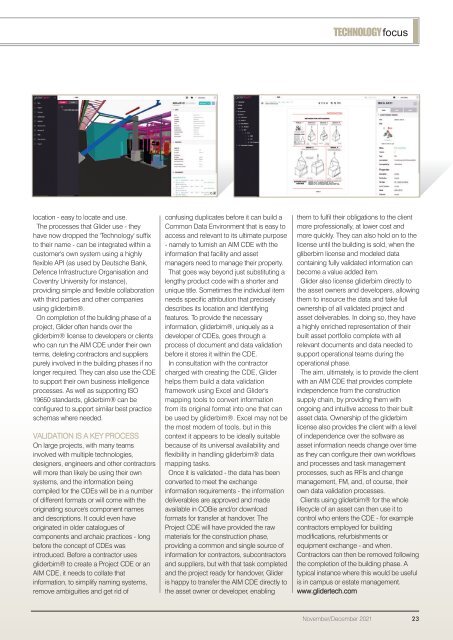CU Nov-Dec 2021
Create successful ePaper yourself
Turn your PDF publications into a flip-book with our unique Google optimized e-Paper software.
TECHNOLOGYfocus<br />
location - easy to locate and use.<br />
The processes that Glider use - they<br />
have now dropped the 'Technology' suffix<br />
to their name - can be integrated within a<br />
customer's own system using a highly<br />
flexible API (as used by Deutsche Bank,<br />
Defence Infrastructure Organisation and<br />
Coventry University for instance),<br />
providing simple and flexible collaboration<br />
with third parties and other companies<br />
using gliderbim®.<br />
On completion of the building phase of a<br />
project, Glider often hands over the<br />
gliderbim® license to developers or clients<br />
who can run the AIM CDE under their own<br />
terms, deleting contractors and suppliers<br />
purely involved in the building phases if no<br />
longer required. They can also use the CDE<br />
to support their own business intelligence<br />
processes. As well as supporting ISO<br />
19650 standards, gliderbim® can be<br />
configured to support similar best practice<br />
schemas where needed.<br />
VALIDATION IS A KEY PROCESS<br />
On large projects, with many teams<br />
involved with multiple technologies,<br />
designers, engineers and other contractors<br />
will more than likely be using their own<br />
systems, and the information being<br />
compiled for the CDEs will be in a number<br />
of different formats or will come with the<br />
originating source's component names<br />
and descriptions. It could even have<br />
originated in older catalogues of<br />
components and archaic practices - long<br />
before the concept of CDEs was<br />
introduced. Before a contractor uses<br />
gliderbim® to create a Project CDE or an<br />
AIM CDE, it needs to collate that<br />
information, to simplify naming systems,<br />
remove ambiguities and get rid of<br />
confusing duplicates before it can build a<br />
Common Data Environment that is easy to<br />
access and relevant to its ultimate purpose<br />
- namely to furnish an AIM CDE with the<br />
information that facility and asset<br />
managers need to manage their property.<br />
That goes way beyond just substituting a<br />
lengthy product code with a shorter and<br />
unique title. Sometimes the individual item<br />
needs specific attribution that precisely<br />
describes its location and identifying<br />
features. To provide the necessary<br />
information, gliderbim®, uniquely as a<br />
developer of CDEs, goes through a<br />
process of document and data validation<br />
before it stores it within the CDE.<br />
In consultation with the contractor<br />
charged with creating the CDE, Glider<br />
helps them build a data validation<br />
framework using Excel and Glider's<br />
mapping tools to convert information<br />
from its original format into one that can<br />
be used by gliderbim®. Excel may not be<br />
the most modern of tools, but in this<br />
context it appears to be ideally suitable<br />
because of its universal availability and<br />
flexibility in handling gliderbim® data<br />
mapping tasks.<br />
Once it is validated - the data has been<br />
converted to meet the exchange<br />
information requirements - the information<br />
deliverables are approved and made<br />
available in COBie and/or download<br />
formats for transfer at handover. The<br />
Project CDE will have provided the raw<br />
materials for the construction phase,<br />
providing a common and single source of<br />
information for contractors, subcontractors<br />
and suppliers, but with that task completed<br />
and the project ready for handover, Glider<br />
is happy to transfer the AIM CDE directly to<br />
the asset owner or developer, enabling<br />
them to fulfil their obligations to the client<br />
more professionally, at lower cost and<br />
more quickly. They can also hold on to the<br />
license until the building is sold, when the<br />
gliberbim license and modeled data<br />
containing fully validated information can<br />
become a value added item.<br />
Glider also license gliderbim directly to<br />
the asset owners and developers, allowing<br />
them to insource the data and take full<br />
ownership of all validated project and<br />
asset deliverables. In doing so, they have<br />
a highly enriched representation of their<br />
built asset portfolio complete with all<br />
relevant documents and data needed to<br />
support operational teams during the<br />
operational phase.<br />
The aim, ultimately, is to provide the client<br />
with an AIM CDE that provides complete<br />
independence from the construction<br />
supply chain, by providing them with<br />
ongoing and intuitive access to their built<br />
asset data. Ownership of the gliderbim<br />
license also provides the client with a level<br />
of independence over the software as<br />
asset information needs change over time<br />
as they can configure their own workflows<br />
and processes and task management<br />
processes, such as RFIs and change<br />
management, FM, and, of course, their<br />
own data validation processes.<br />
Clients using gliderbim® for the whole<br />
lifecycle of an asset can then use it to<br />
control who enters the CDE - for example<br />
contractors employed for building<br />
modifications, refurbishments or<br />
equipment exchange - and when.<br />
Contractors can then be removed following<br />
the completion of the building phase. A<br />
typical instance where this would be useful<br />
is in campus or estate management.<br />
www.glidertech.com<br />
<strong>Nov</strong>ember/<strong>Dec</strong>ember <strong>2021</strong> 23

















